Insects
Mt. Takao is considered one of the three major habitat of insects along with Minoo (Osaka prefecture) and Kibune (Kyoto prefecture) and it has long been loved by researchers of insects because of number of species and the easy access from the Metropolitan area. There are many insects first found in Mt. Takao and named after "Takao" such as Takao Shachihoko (Hiradonta takaonis Matsumura) and Takao medaka kamikiri (Stenhomalus takaosanus).
-
高尾山に生きる多種多様な甲虫たち

 高尾山に生きる多種多様な甲虫たち
高尾山に生きる多種多様な甲虫たち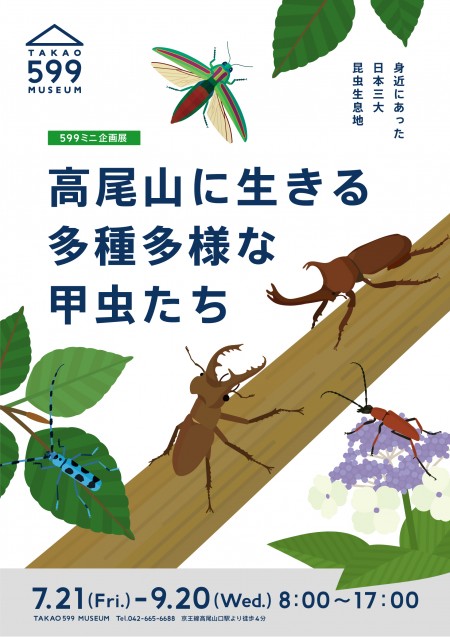 2023年7月21日~2023年9月20日「高尾山に生きる多種多様な甲虫たち」
2023年7月21日~2023年9月20日「高尾山に生きる多種多様な甲虫たち」
高尾山で見られるカブトムシやクワガタムシをはじめとする甲虫たちをご紹介。登る前に立ち寄って、多種多様な甲虫の世界に足を踏み入れてみませんか。
※パネルの内容は展示当時の情報となり、最新の情報とは異なる場合があります。 -
高尾山の水辺が育む生命たち

 高尾山の水辺が育む生命たち
高尾山の水辺が育む生命たち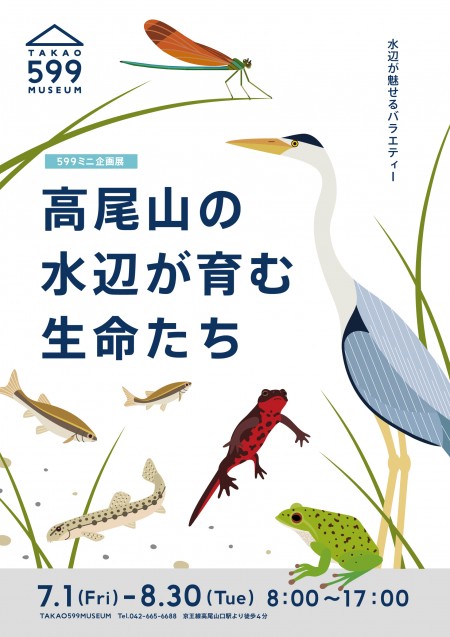 2022年7月1日~2022年8月30日「高尾山の水辺が育む生命たち」
2022年7月1日~2022年8月30日「高尾山の水辺が育む生命たち」
高尾山には川・池・沢・田んぼといった様々な水辺環境があります。それらの水辺では多くの生き物たちが暮らしています。本展示ではトンボや魚、カエルや水鳥などについてご紹介しています。
※パネルの内容は展示当時の情報となり、最新の情報とは異なる場合があります。 -
チョウが舞う高尾山

 チョウが舞う高尾山
チョウが舞う高尾山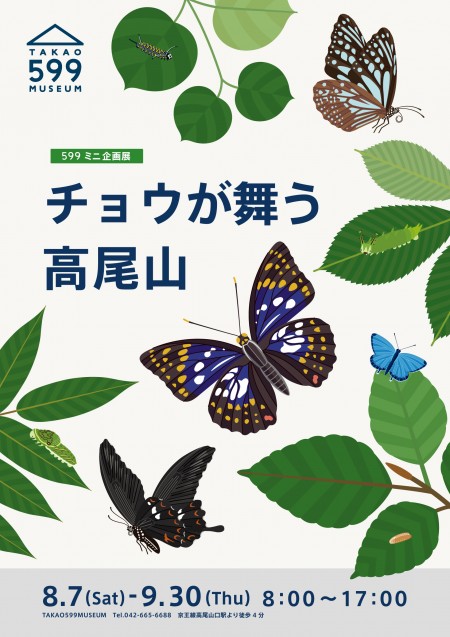 2021年8月7日~2021年9月30日「チョウが舞う高尾山」
2021年8月7日~2021年9月30日「チョウが舞う高尾山」
高尾山で見られるチョウについてご紹介。植物との関係や観察スポットもあわせて解説します。今日からチョウの観察を始めてみませんか。
※パネルの内容は展示当時の情報となり、最新の情報とは異なる場合があります。 -
Papilio xuthus(Asian Swallowtail) Papilionidae
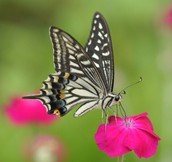
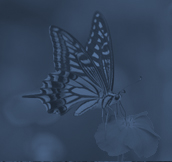 Papilio xuthus(Asian Swallowtail) Papilionidae
Papilio xuthus(Asian Swallowtail) Papilionidae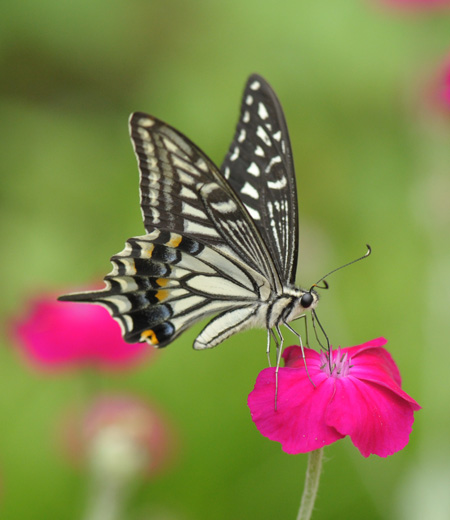 Main Region: Hokkaido, Honshu, Shikoku, Kyushu, Okinawa, Sado Island and Yaku Island.
Main Region: Hokkaido, Honshu, Shikoku, Kyushu, Okinawa, Sado Island and Yaku Island.
Well-known butterfly and often seen in residential areas in cities as well as suburban areas because caterpillars feed on plants in rutaceae family which often planted at gardens or hedges.
This species is so-called swallowtails.
Fly to sunny trees and grasslands and feed on nectar of ericaceae, cirsium and cayratia japonica.
Color of wings is less yellowish yellow-white to white than papilio machaon.
Black lines along wing veins create complicated patterns.
Have blue and red patterns at the bottom of hind wings.
The difference between male and female is the tip of abdomen, male is sharp-shaped because of the reproductive organs and female is more round-shaped.
●Wingspan (length when fore wings are open) about 65 to 90 mm
●Adult Flight Season April to about October -
Papilio machaon (Old World Swallowtail) Papilionidae
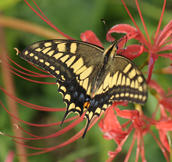
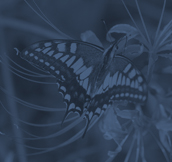 Papilio machaon (Old World Swallowtail) Papilionidae
Papilio machaon (Old World Swallowtail) Papilionidae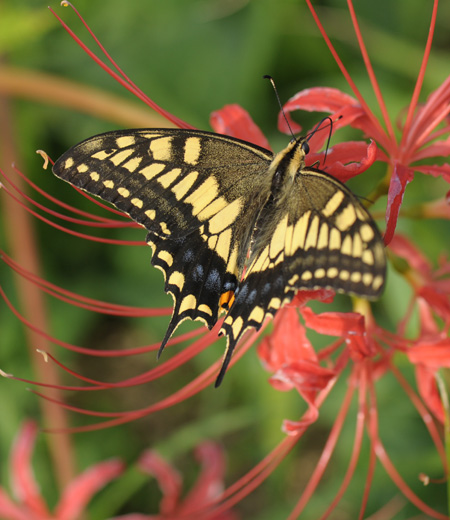 Main Region: Hokkaido, Honshu, Shikoku, Kyushu, Sado Island, Goto Islands and Yaku Island.
Main Region: Hokkaido, Honshu, Shikoku, Kyushu, Sado Island, Goto Islands and Yaku Island.
Prefer sunny grasslands and paddy fields from flatlands to mountains.
Often seen at parks and residential areas in cities.
Adults are also found from flatlands to high lands of 3000 meters elevations, thus living area varies to different elevations.
Fly to green grasslands during the daytime and feed on nectar of ericaceae and cirsium.
Caterpillars feed on leaves of plants in apiaceae family including water dropwort javanica and parsleys.
Body is similar to swallowtail but can be distinguished by the wing color, which more strong yellow as the Japanese name Ki-ageha literally meaning yellow swallowtail states.
And at the base of wings are black without any patterns.
Male holds territory at high elevations, and is often seen around mountain peak.
●Wingspan about 70 to 90 mm
●Adult Flight Season April to about September -
Papilio protenor (Spangle) Papilionidae
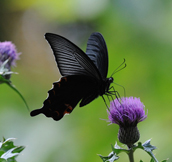
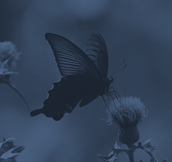 Papilio protenor (Spangle) Papilionidae
Papilio protenor (Spangle) Papilionidae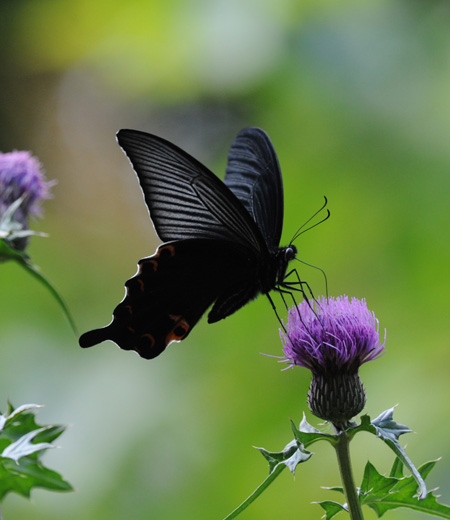 Main Region: Honshu (South of southern Tohoku area), Shikoku, Kyushu, Okinawa and Yaeyama Islands.
Main Region: Honshu (South of southern Tohoku area), Shikoku, Kyushu, Okinawa and Yaeyama Islands.
Prefer shadowy areas and found in woody forests, sometimes seen at parks and residential areas in cities.
In Mt. Takao, often found at mountain trails.
Body color is mat black and tails at the lower tips of hind wings are smaller than other species in papilionidae.
Do not have strong characteristics so it is easy to identify.
On the back of hind wings, male has red spots only on the back and female has them on both sides.
Fly to shady area avoiding sun and feed on nectar of plants in ericaceae family.
Caterpillars feed on leaves of plants in rutaceae family.
●Wingspan about 80 to 120 mm
●Adult Flight Season April to about October -
Papilio macilentus (The Long Tail Spangle) Papilionidae
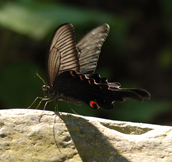
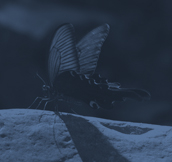 Papilio macilentus (The Long Tail Spangle) Papilionidae
Papilio macilentus (The Long Tail Spangle) Papilionidae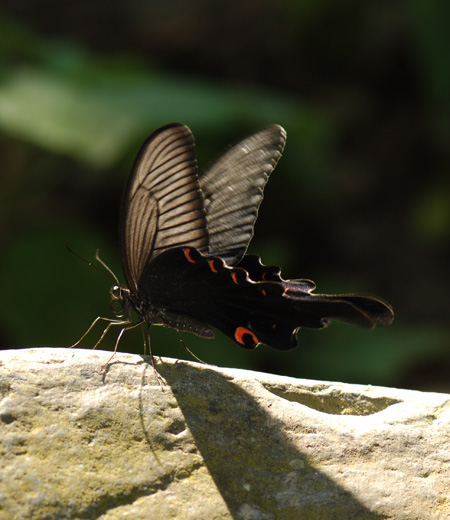 Main Region: Hokkaido, Honshu, Shikoku, Kyushu, Okushiri Island, Sado Island and Shodo Island.
Main Region: Hokkaido, Honshu, Shikoku, Kyushu, Okushiri Island, Sado Island and Shodo Island.
Found in woods on hills or at streamsides in mountains.
Wings are shiny black and have crescent moon-shaped red patterns on edges of hind wings.
These patterns on female are more distinct.
Only male have white front edges of hind wings but this is often covered by fore wings.
Similar to papilio protenor but this species have long tails as Japanese name Onaga-ageha literally meaning long tail swallowtail states.
Fly around streamsides in mountains and feed on nectar from azalea and lilium medeoloides.
Caterpillars feed on leaves of orixa japonica and Japanese pepper.
Only male suck waters at paddles and swamps sometimes do in groups.
●Wingspan about 90 to 110 mm
●Adult Flight Season April to about September -
Papilio bianor (Chinese Peacock) Papilionidae
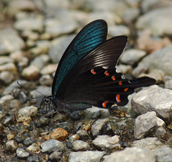
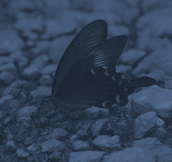 Papilio bianor (Chinese Peacock) Papilionidae
Papilio bianor (Chinese Peacock) Papilionidae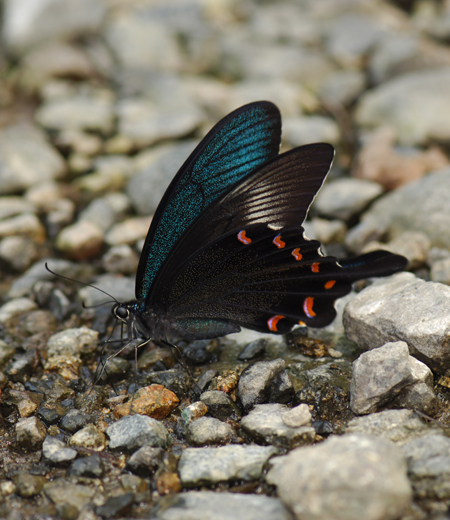 Main Region: Hokkaido, Honshu, Shikoku, Kyushu and other isolated islands including Goto Islands.
Main Region: Hokkaido, Honshu, Shikoku, Kyushu and other isolated islands including Goto Islands.
Found in forests from flatlands to mountains.
Wing color is black and covered by blue-green scales and the colors and brightness differ by viewing angles and are very beautiful.
The back of wings is black with red spots on hind wings.
Male has mat and hairy part on fore wings that are to distinguish male from female.
Is active during daytime and fly fast and feed on nectar of plants in ericaceae family and moss phlox.
Caterpillars feed on leaves of orixa japonica and Japanese pepper.
Only male suck fresh water on mountain trails in Mt. Takao.
Male in papilionidae family fly on the same route regularly, which is called flyway.
●Wingspan about 80 to 110 mm
●Adult Flight Season April to about September -
Papilio maackii(Maackii Peacock) Papilionidae
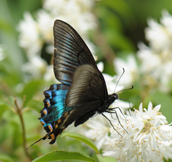
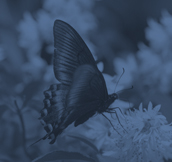 Papilio maackii(Maackii Peacock) Papilionidae
Papilio maackii(Maackii Peacock) Papilionidae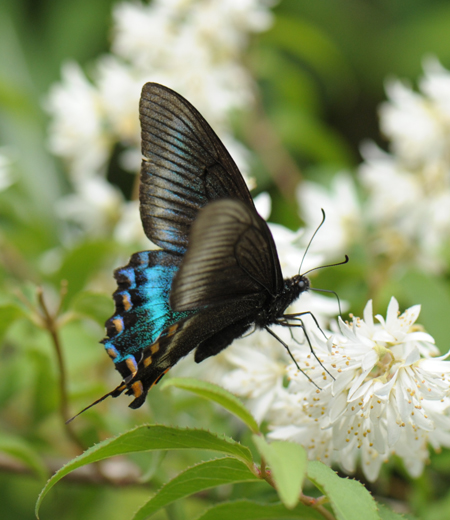 Main Region: Hokkaido, Honshu, Shikoku, Kyushu, Okinawa, Sado Island, Tanega Island and Yaku Island.
Main Region: Hokkaido, Honshu, Shikoku, Kyushu, Okinawa, Sado Island, Tanega Island and Yaku Island.
Found in forests from low elevations to mountains, also in woods along coastline.
Is not too appealing but very beautiful with black wings covered by blue scales creating bright green or deep blue by different viewing angles.
Some says that this species is the most beautiful butterfly representing Japan.
Bright belt-like colors on the back of fore and hind wings are to distinguish them from similar papilio bianor but some species have less distinct patterns.
Male fly to various kinds of places, even at mountain peaks and adults feed on nectar of plants in ericaceae family.
Caterpillars feed on leaves of Japanese prickly-ash.
●Wingspan about 90 to 120 mm
●Adult Flight Season May to about September -
Byasa alcinous (Chinese Windmill) Papilionidae
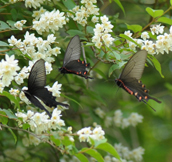
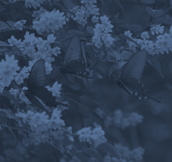 Byasa alcinous (Chinese Windmill) Papilionidae
Byasa alcinous (Chinese Windmill) Papilionidae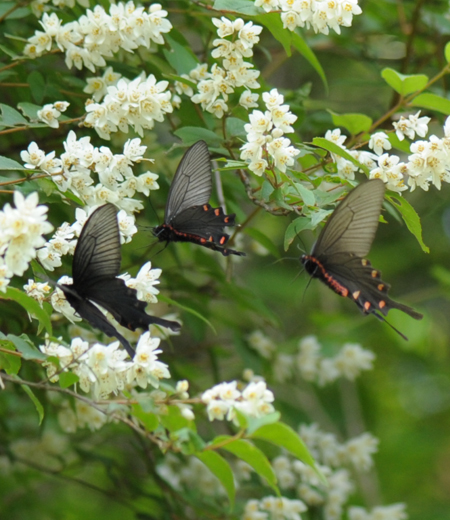 Main Region: Honshu, Shikoku, Kyushu, Okinawa, Goto Islands, Yaku Island and Amami Islands.
Main Region: Honshu, Shikoku, Kyushu, Okinawa, Goto Islands, Yaku Island and Amami Islands.
Found in various places from bright areas of riverbeds and grassland in flatlands to woody areas and forests from flatlands to mountains.
Wing colors differ by sex, male is mat smoky black and female is yellow-gray to dark-gray with distinct black wing veins.
Both male and female have crescent moon-shaped red patterns on the back of hind wings.
Caterpillars feed on aristolochia debilis that are poisonous and the body of caterpillars with red patterns display that they are also poisonous.
Is active during daytime and feed on nectar from plants in ericaceae family, deutzia crenata and in Cirsium family.
Japanese name Jyako-ageha literally meaning musk swallowtail was named because male adults are musk-scented.
●Wingspan about 75 to 100 mm
●Adult Flight Season May to about September -
Papilio helenus (Red Helen) Papilionidae
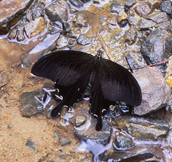
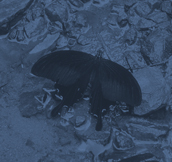 Papilio helenus (Red Helen) Papilionidae
Papilio helenus (Red Helen) Papilionidae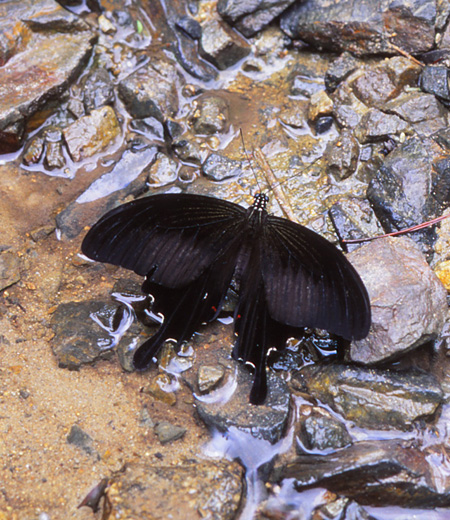 Main Region: Honshu (South of Miyagi prefecture), Shikoku, Kyushu, Okinawa, Goto Islands, Yaku Island and Tanega Island.
Main Region: Honshu (South of Miyagi prefecture), Shikoku, Kyushu, Okinawa, Goto Islands, Yaku Island and Tanega Island.
Is the largest butterfly in Japan.
Found in woody and shady areas from flatlands to mountains.
Have large yellow-white pattern on hind wings and Japanese name Monki-ageha literally meaning yellow pattern swallowtail comes from this color and patterns.
Also have red spots at edges of hind wings and female ones are more distinct.
Is active during daytime, fly in woods and feed on nectar of deutzia crenata, clerodendrum trichotomum and red spider lily.
Caterpillars feed on leaves of Japanese Prickly-ash.
Male holds own flyway at streamsides.
Female body is larger than male.
Wingspan about 110 to 140 mm
Adult Flight Season May to about September -
Graphium sarpedon (Common Bluebottle) Papilionidae
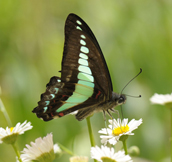
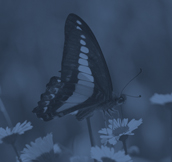 Graphium sarpedon (Common Bluebottle) Papilionidae
Graphium sarpedon (Common Bluebottle) Papilionidae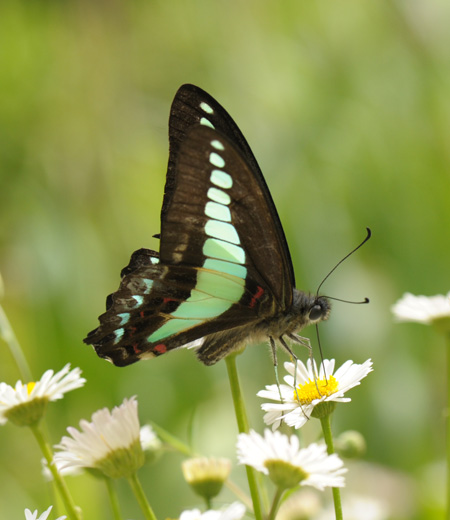 Main Region: Warm climate areas of Honshu (South of southern Tohoku region), Shikoku, Kyushu and Okinawa.
Main Region: Warm climate areas of Honshu (South of southern Tohoku region), Shikoku, Kyushu and Okinawa.
Found in forests from flatlands to low elevations.
Have very distinct light blue belt-like pattern on black wings with red or orange spots on back of wings that are not too appealing while flying.
Found at parks in cities because caterpillars feed on leaves of camphor laurel often planted as street trees.
Fly fast during daytime and feed on nectar of annual fleabane and cayratia japonica.
Male suck water in summer and often seen in groups at watersides.
Wingspan about 50 to 60 mm
Adult Flight Season May to about October -
Parnassius citrinarius (Glacial Apollo, Japanese Clouded Apollo) Papilionidae
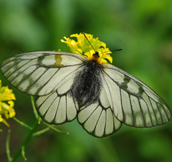
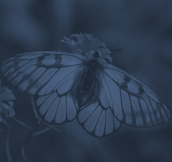 Parnassius citrinarius (Glacial Apollo, Japanese Clouded Apollo) Papilionidae
Parnassius citrinarius (Glacial Apollo, Japanese Clouded Apollo) Papilionidae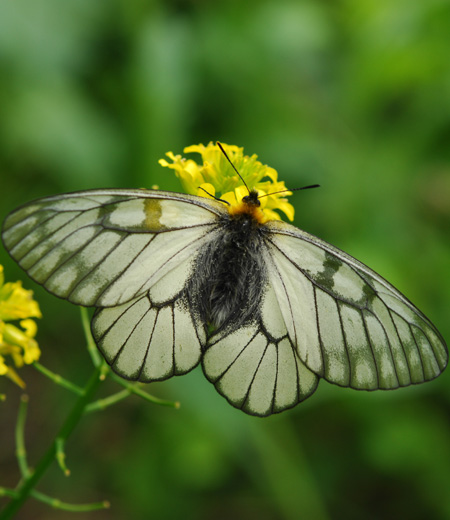 Main Region: Hokkaido, Honshu and Shikoku.
Main Region: Hokkaido, Honshu and Shikoku.
Found in forests, grasslands and farmland from flatlands to mountains.
Japanese name with the word shirocho meaning pieridae but they are in papilionidae family not in pieridae family like small white.
White colored wings have some transparent parts with distinct black wing veins that are unique and beautiful.
Thorax and abdomen are covered with long yellow hairs.
During the daytime, fly slowly in open grasslands and feed on nectar of welsh onion, Astragalus sinicus (Chinese milk vetch), annual fleabane and daikon.
Appear for a short time annually from April to about May.
Caterpillars feed on corydalis incisa and corydalis lineariloba.
Wingspan about 50 to 60 mm
Adult Flight Season April to about May -
Pieris melete Pieridae
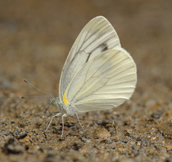
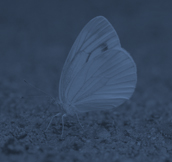 Pieris melete Pieridae
Pieris melete Pieridae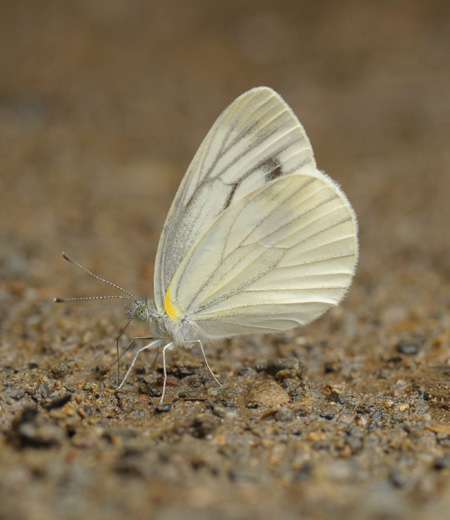 Main Region: Hokkaido, Honshu, Shikoku, Kyushu, Yaku Island and Tanega Island.
Main Region: Hokkaido, Honshu, Shikoku, Kyushu, Yaku Island and Tanega Island.
Found in various kinds of places including green spaces and streamsides in forests from flatlands to mountains, in cities, parks and farmland.
Wing color is white on the front and white to light yellow-white on the back.
Similar to small white, but this species can be distinguished by the distinct black lines along wing veins, hence its Japanese name Sujiguro-Shirocho literally meaning black line white butterfly.
During daytime, fly over grasslands or riversides and feed on nectar of dandelion and boneset.
Is seen from cherry blossoms season.
Caterpillars feed on leaves in brassicaceae family including variableleaf yellowcress.
●Wingspan about 50 to 60 mm
●Adult Flight Season April to about October -
Pieris rapae (Small White) Pieridae
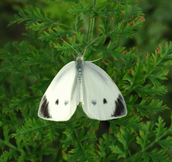
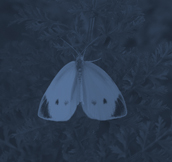 Pieris rapae (Small White) Pieridae
Pieris rapae (Small White) Pieridae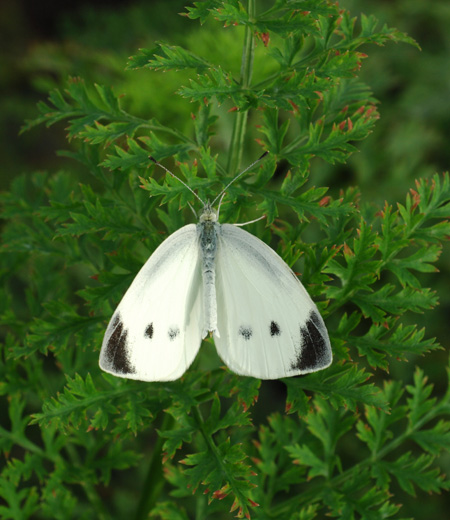 Main Region: Hokkaido, Honshu, Shikoku, Kyushu, Okinawa and islands including Yaku Island and Ishigaki Island.
Main Region: Hokkaido, Honshu, Shikoku, Kyushu, Okinawa and islands including Yaku Island and Ishigaki Island.
Found in sunny forests and grasslands from flatlands to low elevations.
Are well known for the caterpillars feed on leaves of cabbages and often seen around farmland, riverbeds and even at parks in cities.
Main foods for adults are nectar of annual fleabane and dandelion.
Fly over farmlands or open green spaces for nectar of flowers.
Wing color is white on the front with distinct black spots in the middle of fore wings.
Is yellow on the back but female has deeper color than male.
Is seen from early spring to late autumn.
●Wingspan about 45 to 50 mm
●Adult Flight Season March to about November -
Colias erate (Eastern Pale Clouded Yellow) Pieridae
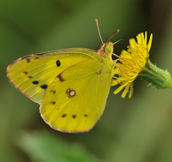
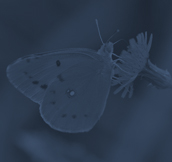 Colias erate (Eastern Pale Clouded Yellow) Pieridae
Colias erate (Eastern Pale Clouded Yellow) Pieridae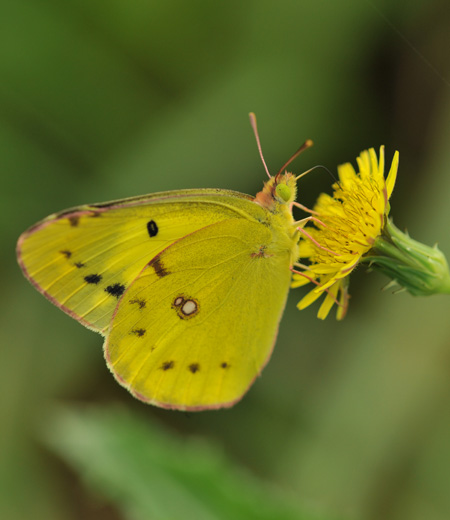 Main Region: Hokkaido, Honshu, Shikoku, Kyushu, Okinawa and islands including Yaku Island and Ishigaki Island.
Main Region: Hokkaido, Honshu, Shikoku, Kyushu, Okinawa and islands including Yaku Island and Ishigaki Island.
Found in grasslands from flatlands to low elevations.
Have wide range of habitat including city centers, parks and rivers in Tokyo.
Wing color is yellow with black spots in the center as the Japanese name Monki-cho literally meaning spotted yellow butterfly states.
Female body colors are in two types, yellow and white.
During daytime, fly closer to the ground over open green spaces and rivers in flatlands and feed on nectar of Philadelphia fleabane, annual fleabane and dandelion.
Only male sucks water.
Caterpillars feed on plants of fabaceae family including red clover and white clover.
Is seen for long time from early spring to late autumn.
●Wingspan about 40 to 50 mm
●Adult Flight Season April to about November -
Eurema mandarina mandarina(Common Grass Yellow) Pieridae
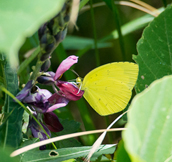
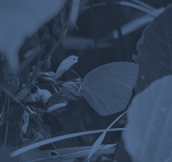 Eurema mandarina mandarina(Common Grass Yellow) Pieridae
Eurema mandarina mandarina(Common Grass Yellow) Pieridae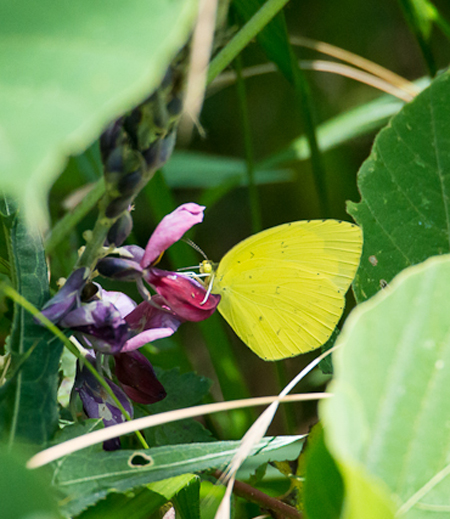 Main Region: Honshu, Shikoku, Kyushu, Okinawa, Sado Island, Yaku Island, Ishigaki Island and Iriomote Island.
Main Region: Honshu, Shikoku, Kyushu, Okinawa, Sado Island, Yaku Island, Ishigaki Island and Iriomote Island.
Common Grass Yellow is the different species found in south of Nansei islands.
Found in sunny grassland and forests from flatlands to mountains.
Is seen from early spring of about March and found even at parks in Tokyo.
Wing color is generally yellow on both sides and male is deeper yellow and female is lighter yellow.
Have black colored edges.
Some have black spots on the back of wings but some do not.
Fly over sunny grasslands or forests and feed on nectar of bush clover, cisium and bidens.
Caterpillars feed on plants in fabaceae family including mimosa.
Wingspan about 35 to 45 mm
Adult Flight Season March to about November -
Anthocharis scolymus Pieridae
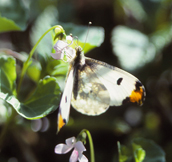
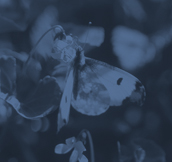 Anthocharis scolymus Pieridae
Anthocharis scolymus Pieridae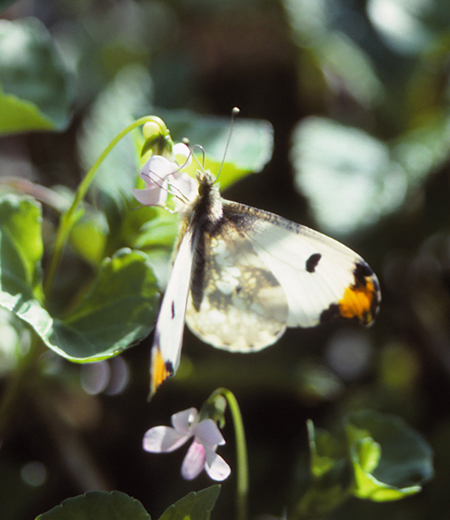 Main Region: Hokkaido, Honshu, Shikoku, Kyushu, Sado Island and Nansei Islands.
Main Region: Hokkaido, Honshu, Shikoku, Kyushu, Sado Island and Nansei Islands.
Found in forests, grasslands and riverbeds from flatlands to low elevations.
Wing color is white with black spots on the front and tip of fore wings are yellow and pointed, hence Japanese name Tsumaki-cho literally meaning corner pointed yellow butterfly.
This yellow edge only applies for male and female does not.
Have irregular green patterns on the back of wings resembling dead leaves.
Flying style is unique and fly straight over grasslands and riverbeds and feed on nectar of dandelion and corydalis incisa.
Caterpillars feed on brassicaceae including variableleaf yellowcress and shepherd's purse.
Is only seen during spring season.
●Wingspan about 45 to 50 mm
●Adult Flight Season March to about May -
Vanessa indica(Indian Red Admiral) Nymphalidae
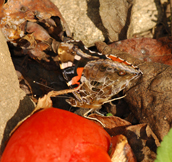
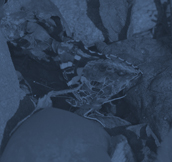 Vanessa indica(Indian Red Admiral) Nymphalidae
Vanessa indica(Indian Red Admiral) Nymphalidae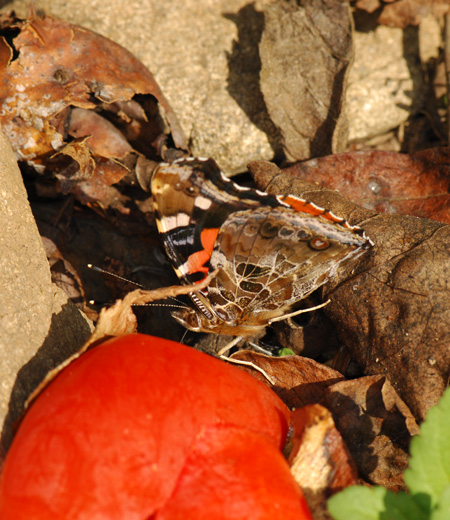 Main Region: Hokkaido, Honshu, Shikoku, Kyushu and Nansei Islands.
Main Region: Hokkaido, Honshu, Shikoku, Kyushu and Nansei Islands.
Often found in various kinds of places from flatlands to mountains including coastlines, grasslands in high elevations, residential areas and cities.
Fore wings are strong reddish orange as the Japanese name Aka-tateha literally meaning red-nymphalidae states, with black tips with white spots.
Hind wings are deep brown with orange edges on the bottom.
Back of fore wings is quite similar to the front but some have blue spots with spider web-like complicated patterns.
Adults fly to flowers of cirsium family and clethra barbinervis for nectar, trees for sap and rotten fruits.
Caterpillars feed on leaves of plants in urticaceae family including ramie and boehmeria japonica, and ulmaceae family including Japanese zelkova.
●Wingspan about 55 to 60 mm
●Adult Flight Season March to about November -
Vanessa cardui (Painted Lady) Nymphalidae
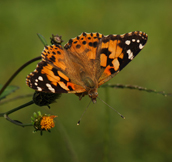
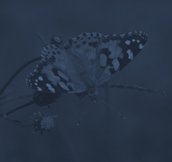 Vanessa cardui (Painted Lady) Nymphalidae
Vanessa cardui (Painted Lady) Nymphalidae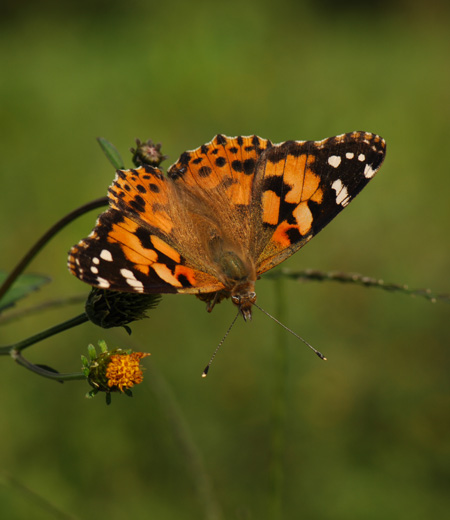 Main Region: All over Japan, Hokkaido, Honshu, Shikoku, Kyushu and Nansei Islands.
Main Region: All over Japan, Hokkaido, Honshu, Shikoku, Kyushu and Nansei Islands.
Found in sunny grasslands from flatlands to mountains at wide range of areas such as open fields, parks, from cities to suburban areas, in farmlands and riversides.
Similar to vanessa indica found in Mt. Takao, but the color of this species is less reddish on the hind wings.
Back of wings is also similar to vanessa indica but this species have more white parts and look rather white.
During the daytime, fly fast over grasslands and gather at flowers of dandelion, cirsium and cosmea for nectar.
Caterpillars feed on leaves of mugwort and edible burdock.
Sometimes are heavily infested at edible burdock farms and cause damage.
●Wingspan about 40 to 50 mm
●Adult Flight Season April to about November -
Polygonia c-aureum(Comma Butterfly) Nymphalidae
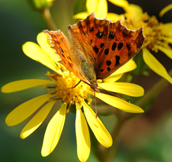
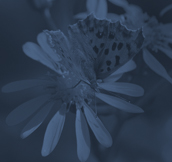 Polygonia c-aureum(Comma Butterfly) Nymphalidae
Polygonia c-aureum(Comma Butterfly) Nymphalidae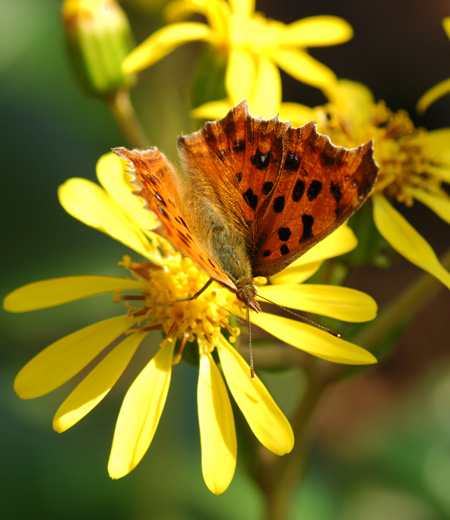 Main Region: Hokkaido, Honshu and Shikoku.
Main Region: Hokkaido, Honshu and Shikoku.
Found in grasslands and riverbeds from flatlands to low elevations, prefer sunny environment and also often found in residential areas and parks.
The front side of wings are orangey red-brown with many black spots and small blue spots at the bottom.
Female is lighter red-brown.
Back of wings has black lines along wing veins and white to brown shaded wavy patterns resembling dead leaves.
During daytime, fly closer to the ground in grasslands and feed on nectar of annual fleabane.
Also gather around tree sap and rotten fruits.
Caterpillars feed on leaves of plants in cannabaceae family including Japanese hop, cannabis and Humulus lupulus var. cordifolius.
●Wingspan about 50 to 60 mm
●Adult Flight Season March to about November -
Nymphalis anthomelas (Scarce Tortoiseshell) Nymphalidae
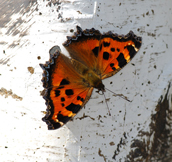
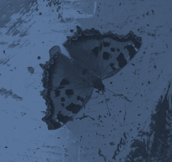 Nymphalis anthomelas (Scarce Tortoiseshell) Nymphalidae
Nymphalis anthomelas (Scarce Tortoiseshell) Nymphalidae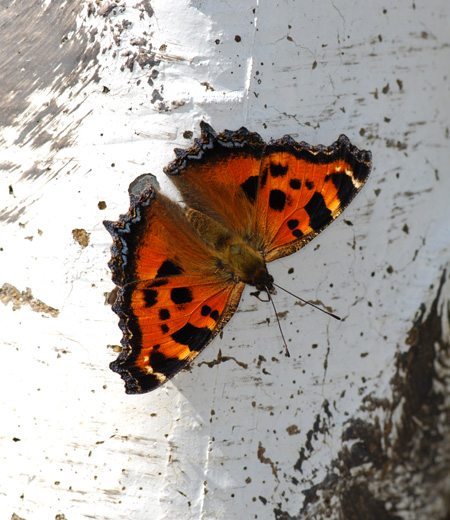 Main Region: Hokkaido, Honshu, Shikoku and Kyushu.
Main Region: Hokkaido, Honshu, Shikoku and Kyushu.
Found in forests and woods from low elevations to mountains.
Japanese name Hiodoshi-cho literally meaning scarlet threaded suit of armor was named because the body color is scarlet which remind people of scarlet threaded suit of armor.
Wing color is orange with many big black spots in the center and black edges with blue spots.
Back of wings have bark-like patterns, thus it is hard to recognize when they rest on tree.
Spend winter after emerged to adults and are seen from early spring around flowers of cerasus ×yedoensis A.V.Vassil.
‘Somei-yoshino’ and Japanese apricot.
Caterpillars feed on leaves of plants in ulmaceae family including Chinese Hackberry and Salicaceae family.
●Wingspan about 60 to 71 mm
●Adult Flight Season March to about November -
Kaniska canace (Blue Admiral) Nymphalidae
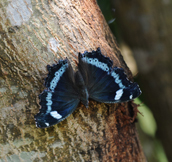
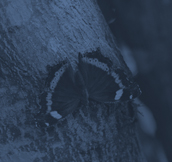 Kaniska canace (Blue Admiral) Nymphalidae
Kaniska canace (Blue Admiral) Nymphalidae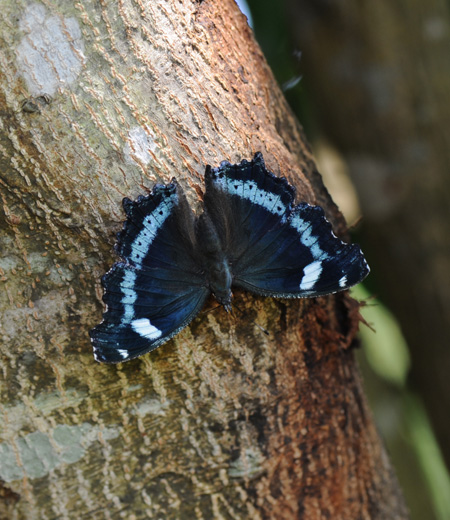 Main Region: Hokkaido, Honshu, Shikoku, Kyushu and Nansei Islands.
Main Region: Hokkaido, Honshu, Shikoku, Kyushu and Nansei Islands.
Found in sunny woods from flatlands to mountains.
Have lazuline colored belt-like pattern runs halfway around the wings.
Tips of fore wings are wide and extended and female have more rounded edges.
Back of wings is dark brown and resembles bark or dead leaves color.
Spend winter after emerged to adults and are seen from early spring and gather around tree sap and rotten fruits.
Hardly fly to flowers.
Caterpillars feed on leaves of plants in liliaceae family including China root, catbrier, tiger lily, lilium speciosum, smilax sieboldii and tricyrtis affinis.
●Wingspan about 50 to 65 mm
●Adult Flight Season March to about November -
Araschnia burejana Nymphalidae
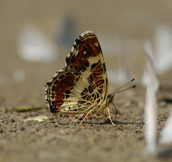
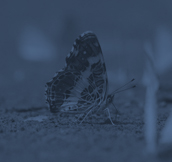 Araschnia burejana Nymphalidae
Araschnia burejana Nymphalidae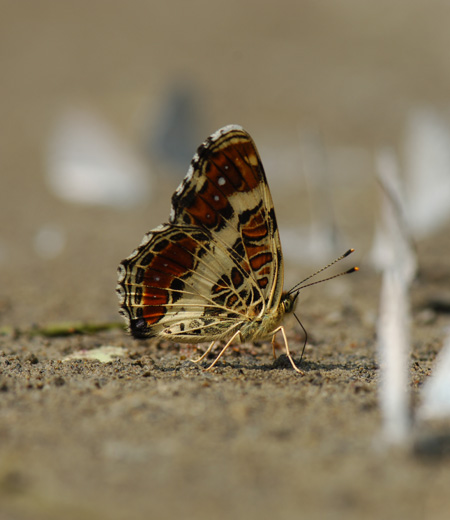 Main Region: Hokkaido, Honshu, Shikoku, Kyushu, Okushiri Island and Sado Island.
Main Region: Hokkaido, Honshu, Shikoku, Kyushu, Okushiri Island and Sado Island.
Found in forests and grasslands from flatlands to mountains.
Also found at streamsides and mountain trails.
Japanese name Saka-hachi-cho literally meaning number eight in Chinese character placed upside-down butterfly was named because white patterns on wings resemble Chinese characters of number eight placed upside-down.
Wing color differs by season they emerge.
Ones in spring are dark brown with irregular orange patterns and white belt-like pattern is less distinct.
Ones in summer are black color and white belt-like pattern is distinct along with orange lines.
During the daytime, fly closer to the ground and feed on nectar of plants in apiaceae family.
Also fly to dungs of animals and suck water.
Caterpillars feed on leaves of plants in urticaceae family.
●Wingspan about 35 to 45 mm
●Adult Flight Season April to about October -
Sasakia charonda (Great Purple Emperor) Nymphalidae
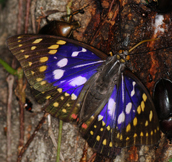
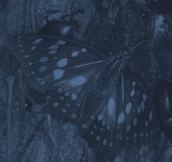 Sasakia charonda (Great Purple Emperor) Nymphalidae
Sasakia charonda (Great Purple Emperor) Nymphalidae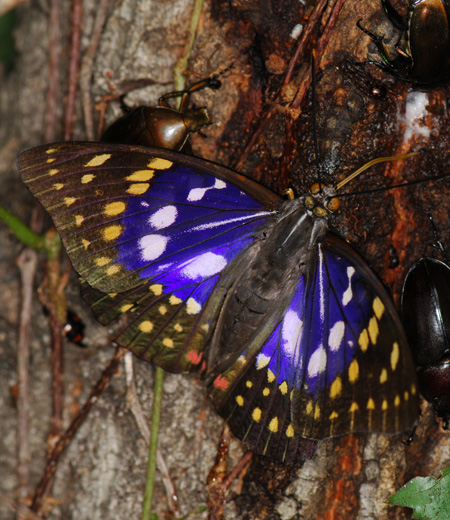 Main Region: Hokkaido, Honshu, Shikoku, Kyushu and Sado Island.
Main Region: Hokkaido, Honshu, Shikoku, Kyushu and Sado Island.
Found in woods or beechwood forests from lowlands to low elevations.
Is the largest species in nymphalidae family in Honshu and is a national butterfly of Japan.
Is known as a beautiful butterfly and wings of male are black-brown with white and yellow spots and the base of wings are bluish purple color, hence the Japanese name Oo-murasaki literally meaning big purple.
Female is brown. Flies fast and feed on sap from sawtooth oak and quercus serrata and juice from rotten fruits.
Caterpillars feed on leaves of Chinese hackberry and celtis jessoensis.
Male shows strong territorial habit and fly over trees and even chase birds such as sparrows.
●Wingspan about 75 to 110 mm
●Adult Flight Season June to about August -
Hestina persimilis japonica (Siren) Nymphalidae
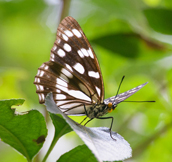
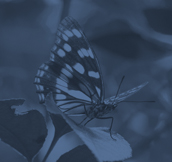 Hestina persimilis japonica (Siren) Nymphalidae
Hestina persimilis japonica (Siren) Nymphalidae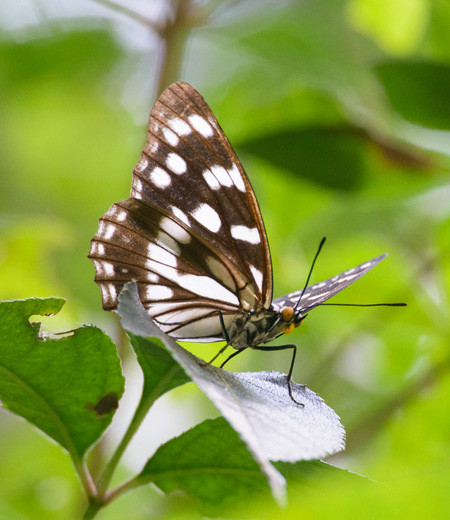 Main Region: Some parts of Hokkaido, Honshu, Shikoku, Kyushu, Sado Island and Tsushima.
Main Region: Some parts of Hokkaido, Honshu, Shikoku, Kyushu, Sado Island and Tsushima.
Found in woods and green spaces from flatlands to low elevations, and also at parks and farmland in cities.
The front of wings is black with many irregularly placed white spots.
Has similar patterns on the back but color is rather brown.
Face feature is unique, compound eyes that comprise of numbers of ommatidia and colored orange.
Mouth is bright yellow and very appealing.
During the daytime, flies over woods and surrounding areas.
Fly to rotten fruits and often suck water on the ground.
Caterpillars feed on leaves of Chinese hackberry and celtis jessoensis.
Lately, a foreign specie, hestina assimilis with red spots on hind wings is seen in many places that is supposed to be seen only in Amami Island.
It is considered that this is man-caused and become an issue in Japan.
●Wingspan about 60 to 80 mm
●Adult Flight Season May to about September -
Dichorragia nesimachus (Asian Constable Butterfly) Nymphalidae
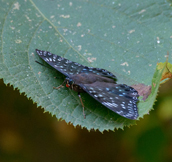
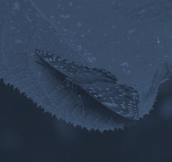 Dichorragia nesimachus (Asian Constable Butterfly) Nymphalidae
Dichorragia nesimachus (Asian Constable Butterfly) Nymphalidae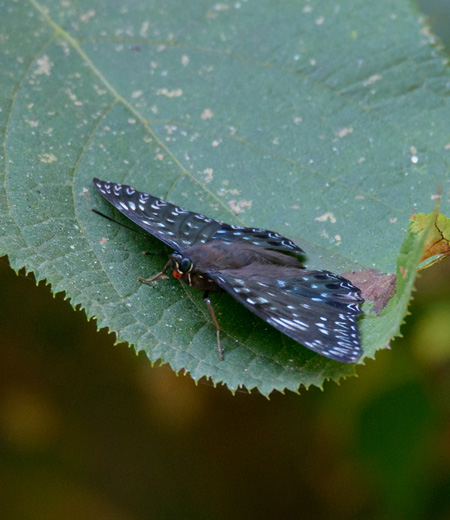 Main Region: Honshu, Shikoku, Kyushu, Okinawa, Sado Island, Tsushima and Nansei Islands.
Main Region: Honshu, Shikoku, Kyushu, Okinawa, Sado Island, Tsushima and Nansei Islands.
Found in sunny woods and mountain trails from flatlands to low elevations.
The patterns on wings are like marbling with Indian ink, hence the Japanese name Suminagashi literally meaning marbling with Indian ink.
Wing colors on the front is light Indian ink with shiny blue-green that is unique color and patterns.
And wing colors on the back is dark brown with distinct white patterns.
Proboscis is red this is also unique feature of this species.
During daytime, fly fast and gathers around sap of sawtooth oak, rotten fruits and dungs of animals.
Also suck water on the ground.
Caterpillars feed on leaves of meliosma myrianth.
Male shows territorial habit at mountain peak of open spaces in forests.
●Wingspan about 55 to 65 mm
●Adult Flight Season May to about August -
Limenitis camilla (White Admiral) Nymphalidae
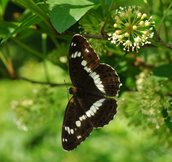
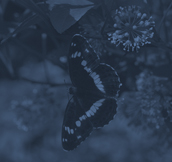 Limenitis camilla (White Admiral) Nymphalidae
Limenitis camilla (White Admiral) Nymphalidae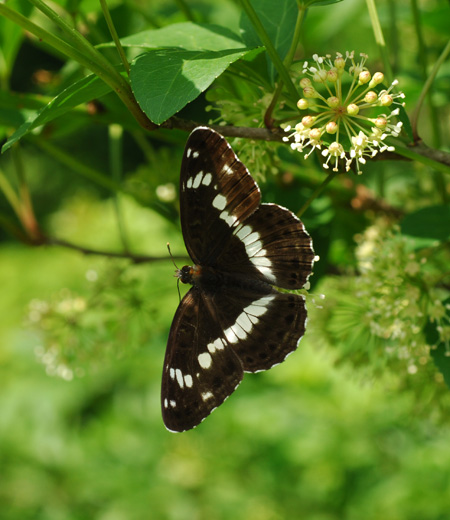 Main Region: Hokkaido, Honshu, Shikoku and Kyushu.
Main Region: Hokkaido, Honshu, Shikoku and Kyushu.
Found in woods and green spaces from flatlands to mountains.
Japanese name Ichi-monji-cho literally meaning one straight line butterfly is named because it has white belt-like patterns in the center of each wing that is very distinct.
The back of wings is red-brown and also have white belt-like pattern along with black spots.
Female body is larger than male and wings are round edges that are to distinguish them from male.
During daytime, fly slowly close to the ground in sunny open grasslands and fly over to flowers of Japanese honeysuckles and clethra barbinervis for nectar.
Caterpillars feed on leaves of plants in caprifoliaceae family including Japanese honeysuckles, lonicera morrowii and Weigela coraeensis.
●Wingspan about 50 to 65 mm
●Adult Flight Season May to about October -
Argynnis paphia (Silver-washed Fritillary) Nymphalidae
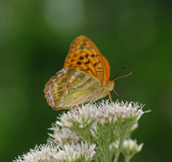
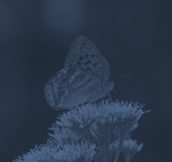 Argynnis paphia (Silver-washed Fritillary) Nymphalidae
Argynnis paphia (Silver-washed Fritillary) Nymphalidae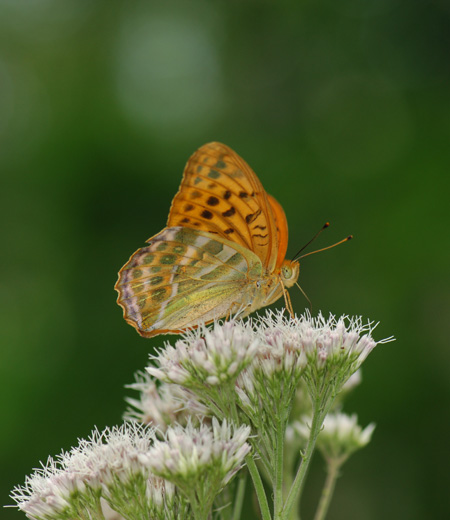 Main Region: Hokkaido, Honshu, Shikoku an, Kyushu.
Main Region: Hokkaido, Honshu, Shikoku an, Kyushu.
Found in woods and mountain trails from flatlands to mountains.
Adults emerge (the last step to become an adult) in early summer, go dormant in summer time and become active in autumn.
Wing color is dark orange with many black spots creating leopard-like patterns.
Male has four thick black lines in the center of fore wings that can be distinguished from female.
The back of hind wings is slightly green, hence the Japanese name Midori-hyo-mon literally meaning green leopard-like patterns.
Resemble the anadyomene fritillary but this species has white lines on the back of hind wings.
Main food for adults is nectar of boneset.
Fly fast from flowers to flowers in forests.
Male sucks water.
Caterpillars feed on plants in violaceae.
●Wingspan about 65 to 70 mm
●Adult Flight Season June to about September -
Nephargynnis anadyomene ( Anadyomene Fritillary) Nymphalidae
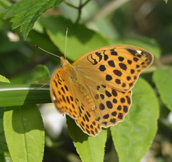
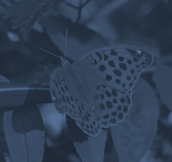 Nephargynnis anadyomene ( Anadyomene Fritillary) Nymphalidae
Nephargynnis anadyomene ( Anadyomene Fritillary) Nymphalidae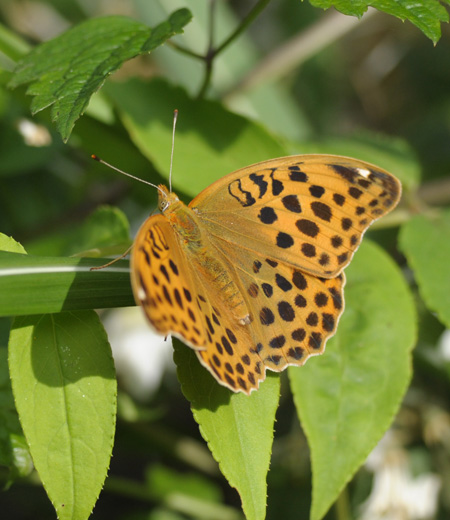 Main Region: Hokkaido, Honshu, Shikoku, Kyushu and Sado Island.
Main Region: Hokkaido, Honshu, Shikoku, Kyushu and Sado Island.
Found in forests, mountain trails and valleys from low elevations to mountains.
Wing color is orange but female is darker with white spots at edges.
Also many black spots create leopard-like pattern, hence the Japanese name Kumogata-hyo-mon literally meaning cloud leopard-like patterns.
The back of wings is grayish yellow-green with lightly white shaded in some parts.
Japanese name come from these white patterns resembling clouds.
These white patterns are unique to this species so it is easy to distinguish them from other butterflies in argynnini tribe.
Have different biological cycle than other butterflies, adults emerge around May, go dormant in summer and become active in autumn.
Adults feed on nectar of plants in cirsium family.
Caterpillar feed on leaves of viola.
●Wingspan about 65 to 75 mm
●Adult Flight Season May to about October -
Argyreus hyperbius(Indian Fritillary) Nymphalidae
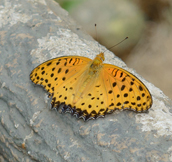
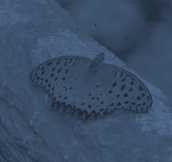 Argyreus hyperbius(Indian Fritillary) Nymphalidae
Argyreus hyperbius(Indian Fritillary) Nymphalidae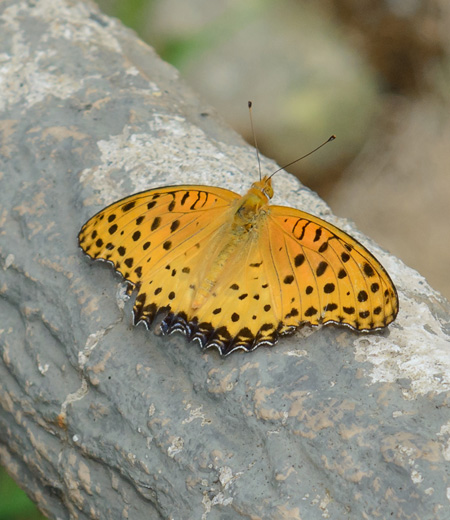 Main Region: Honshu (West of Kanto region), Shikoku, Kyushu and Nansei Islands.
Main Region: Honshu (West of Kanto region), Shikoku, Kyushu and Nansei Islands.
Found in southern areas as seen from main regions.
Found in grasslands and green spaces from flatlands to low elevations, and also at parks and farmlands.
Caterpillars feed on leaves of pansy, thus it is often seen in cities.
Japanese name Tsuma-guro -hyo-mon literally meaning corner pointed black leopard-like patterns was named because tips of fore wings are black that is unique to female and male have leopard-like patterns on entire body.
Have black edges at the bottom of hind wings that can be distinguished from other butterflies in argynnini tribe.
Have light brown body color with yellow-brown leopard-like patterns on the back of wings.
Caterpillars feed on leaves of plants in violaceae family.
●Wingspan about 60 to 70 mm
●Adult Flight Season June to about October -
Neptis philyra Nymphalidae
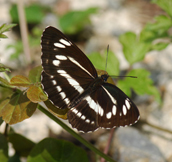
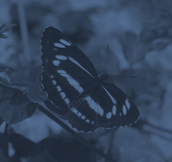 Neptis philyra Nymphalidae
Neptis philyra Nymphalidae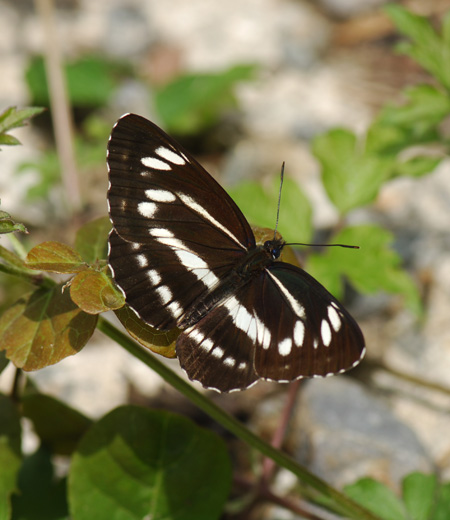 Main Region: Hokkaido, Honshu, Shikoku, Kyushu, Sado Island and Tsushima.
Main Region: Hokkaido, Honshu, Shikoku, Kyushu, Sado Island and Tsushima.
Found in forests and green spaces with plants in aceraceae family from flatlands to mountains.
Have distinct white lines on black-brown wings, as Japanese name Mistuji-cho literally meaning three lines butterfly states.
Similar to common glider and neptis aiwina but the upper lines on wings are thinner and straight on this species.
Have similar patterns on the back of wings but base color is more brownish.
Adults feed on water and dungs of animals not flowers.
Caterpillars feed on plants in aceraceae family including Matsumurae maple and Japanese maple.
Flying style is unique; fly by flattering wings for a short while and then glide (without flattering wings).
●Wingspan about 55 to 70 mm
●Adult Flight Season May to about August -
Neptis sappho (Common Glider) Nymphalidae
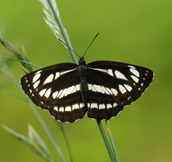
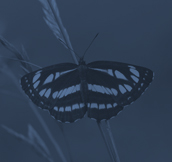 Neptis sappho (Common Glider) Nymphalidae
Neptis sappho (Common Glider) Nymphalidae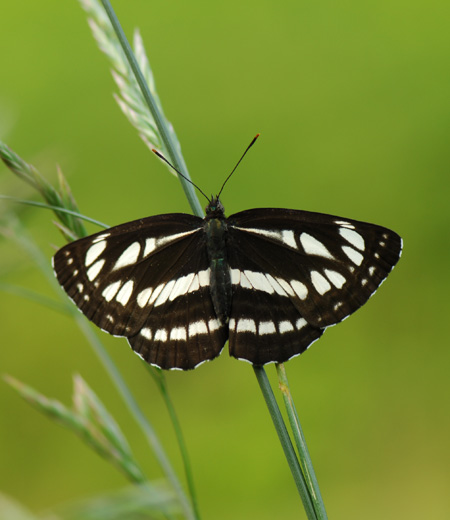 Main Region: Hokkaido, Honshu, Shikoku, Kyushu, Sado Island, Tsushima and Yaku Island.
Main Region: Hokkaido, Honshu, Shikoku, Kyushu, Sado Island, Tsushima and Yaku Island.
Found in forests and woods from flatlands to mountains.
Also found at parks and farmlands.
Have three distinct white lines on black-brown wings.
The upper lines split in two whereas similar neptis philyra has straight lines.
Color on the back of wings is reddish brown with white belt-like patterns.
Fly by flattering wings and glide just like neptis philyra does.
Adults feed on nectar of Ligustrum obtusifolium, rotten fruits, tree sap and dungs of animals.
Caterpillars feed on leaves of plants in Fabaceae family including kudzu.
●Wingspan about 44 to 55 mm
●Adult Flight Season April to about October -
Libythea lepita (Nettle-tree Butterfly) Nymphalidae
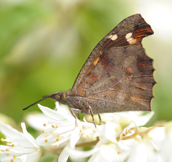
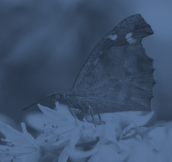 Libythea lepita (Nettle-tree Butterfly) Nymphalidae
Libythea lepita (Nettle-tree Butterfly) Nymphalidae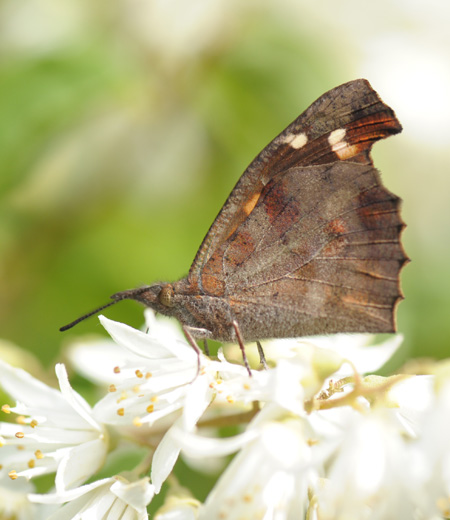 Main Region: Some parts of Hokkaido, Honshu, Shikoku, Kyushu and Nansei Islands.
Main Region: Some parts of Hokkaido, Honshu, Shikoku, Kyushu and Nansei Islands.
Found in woods with Chinese hackberry that caterpillar feed on, rivers and valleys in forests from flatlands to mountains.
The protrusion at the tip of head resemble the nose of long nosed goblin, hence the Japanese name Tengu-cho literally meaning long nosed goblin butterfly.
Shapes of wings are unique with the extended tips of fore wings.
Wing colors on the front is black-brown with irregularly placed orange spots.
The back of wings is brown but more reddish for female.
The entire wing colors is like dead leaves, thus it is hard to recognize when resting on branch with wings closed.
Feed on nectar and sap of various flowers and trees.
Fly to these flowers and trees during daytime.
●Wingspan 40 to 50 mm
●Adult Flight Season March to November -
Parantica sita (Chestnut Tiger) Nymphalidae
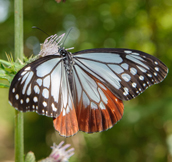
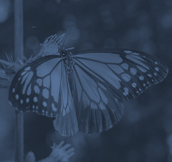 Parantica sita (Chestnut Tiger) Nymphalidae
Parantica sita (Chestnut Tiger) Nymphalidae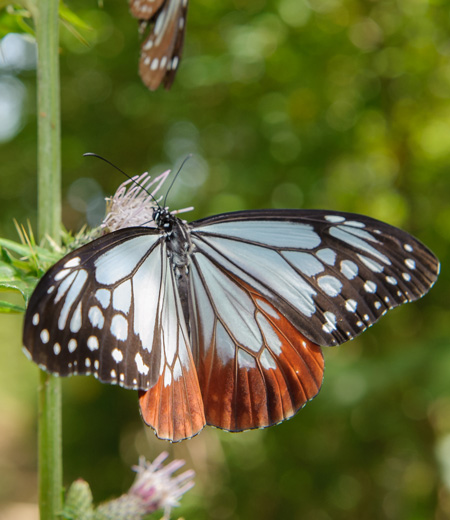 Main Region: Honshu, Shikoku, Kyushu and Nansei Islands.
Main Region: Honshu, Shikoku, Kyushu and Nansei Islands.
Found in forests and grasslands from flatlands to mountains.
Fore wings is black and hind wings is red-brown, and both with light blue patterns.
Japanese name Asagi-cho literally meaning light blue-green butterfly came from this light blue-green that is used to be called as Asagi color.
Caterpillars feed on toxic plants like marsdenia tomentosa to intake the toxicity.
Adults are also toxic and not attacked by enemies.
Fly elegantly during daytime to plants in cirsium family and boneset for nectar.
It is confirmed that they also fly long distance for hundreds of kilometers.
In summer, fly north to lay eggs in forests in mountains.
And in autumn, emerged adults come down to south.
●Wingspan about 100 mm
●Adult Flight Season Apil to about October -
Lethe sicelis Nymphalidae
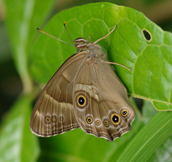
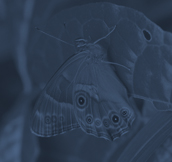 Lethe sicelis Nymphalidae
Lethe sicelis Nymphalidae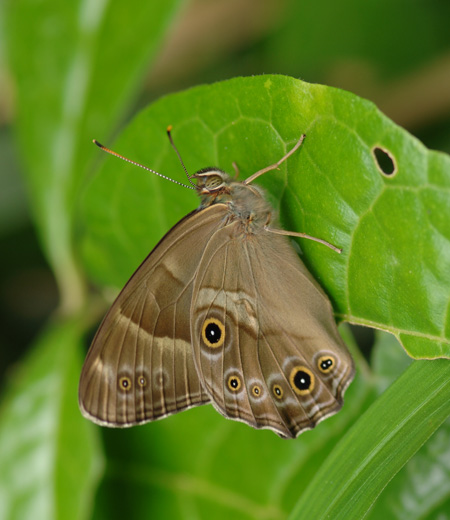 Main Region: Honshu, Shikoku and some parts of Kyushu.
Main Region: Honshu, Shikoku and some parts of Kyushu.
Found in bushes and woods from flatlands to low elevations.
Similar to the Diana treebrown but this species have slightly light brown colored wings.
Fore wings are with white belt-like pattern.
Have even lighter brown color on the back.
Have eyespots (eyelike markings) like lethe diana, one or two small ones on the front and six various sized ones on the back.
These eyespots are unique to satyrinae family.
Having light base color makes these patterns appear more distinct.
Fly around forests during daytime but become even more active in late afternoon to sunset.
Feed on tree sap of quercus acutissima and quercus serrata.
Caterpillars feed on leaves of Japanese timber bamboo and arundinaria ramosa.
●Wingspan about 50 to 60 mm
●Adult Flight Season May to about September -
Lethe diana(Diana Treebrown) Nymphalidae
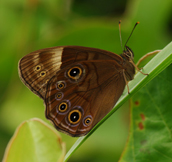
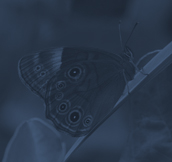 Lethe diana(Diana Treebrown) Nymphalidae
Lethe diana(Diana Treebrown) Nymphalidae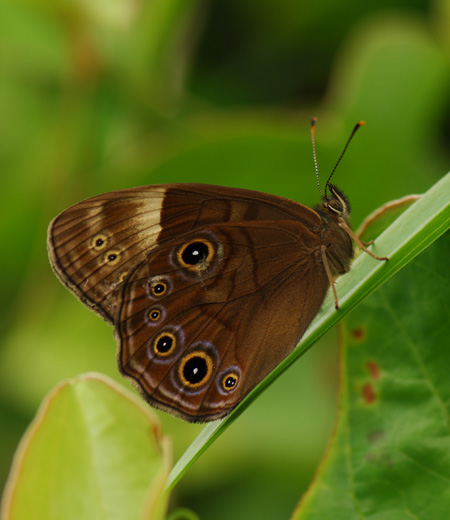 Main Region: Hokkaido, Honshu, Shikoku, Kyushu and islands including Tsushima.
Main Region: Hokkaido, Honshu, Shikoku, Kyushu and islands including Tsushima.
Found in shady woods from flatlands to mountains.
Is often found on mountain trails in Mt. Takao.
Fore wings are black-brown, shaded from light to dark and some have white belt-like patterns.
These patterns are more distinct on female.
Hind wings are black-brown with eyespots on the back.
Have one or two small eyespots on fore wings and six various sized ones on hind wings.
Feed on tree sap of quercus acutissima and quercus serrata and fly during daytime.
Caterpillars feed on leaves of plants in Bambusoideae family including sasa veitchii and pleioblastus chino var. viridis.
Wingspan about 45 to 55 mm
Adult Flight Season May to about September -
Neope goschkevitschii (Goschkevitschi’s Labyrinth) Nymphalidae
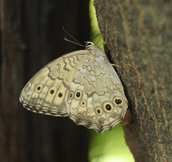
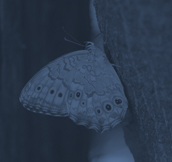 Neope goschkevitschii (Goschkevitschi’s Labyrinth) Nymphalidae
Neope goschkevitschii (Goschkevitschi’s Labyrinth) Nymphalidae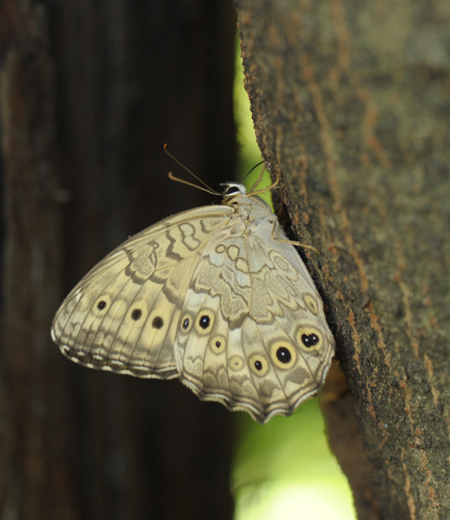 Main Region: Hokkaido, Honshu, Shikoku and Kyushu.
Main Region: Hokkaido, Honshu, Shikoku and Kyushu.
Found in woods from flatlands to low elevations and also at parks and residential areas in cities.
Wing color on the front is brown with yellow lines along wing veins and yellow round-shaped patterns outside of these lines.
The back of wings is yellow-white to yellow-brown with brown wavy patterns and various sized eyespots.
Prefer shady areas than open bright spaces.
Fly in woods and bamboo bushes.
Become more active after sunset than daytime and fly to quercus acutissima and quercus serrata for sap.
Also feed on dungs of animals and fruits, not nectar.
Caterpillars feed on leaves of sasa veitchii and Japanese timber bamboo.
●Wingspan about 55 to 63 mm
●Adult Flight Season May to about August -
Mycalesis francisca (The Lillacine Bushbrown) Nymphalidae
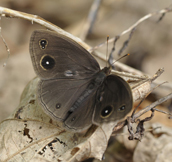
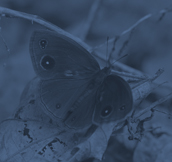 Mycalesis francisca (The Lillacine Bushbrown) Nymphalidae
Mycalesis francisca (The Lillacine Bushbrown) Nymphalidae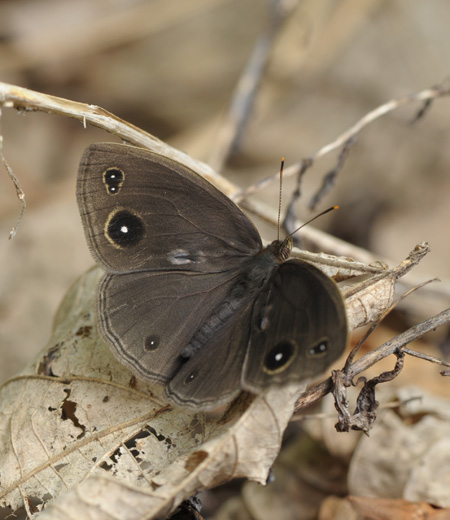 Main Region: Honshu, Shikoku and Kyushu.
Main Region: Honshu, Shikoku and Kyushu.
Found in shady forests and bushes from flatlands to low elevations.
Wing color on the front is black-brown to light gray-brown and on the back is lighter color on edges outside of purplish belt-like patterns.
Eyespots on the front are two to three on fore wings and some have them on hind wings, and on the back are three on fore wings and six to seven on hind wings.
Are active during daytime and fly around trees, plants and flowers.
Feed on sap of quercus acutissima and quercus serrata and also dungs of animals and hardly on nectar of flowers.
Caterpillars feed on leaves of plants in poaceae family including oplismenus undulatifolius, Microstegium vimineum (Trin.) and miscanthus sinensis.
●Wingspan about 40 to 50 mm
●Adult Flight Season April to about October -
Ypthima argus Nymphalidae
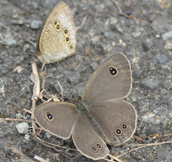
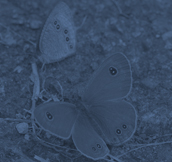 Ypthima argus Nymphalidae
Ypthima argus Nymphalidae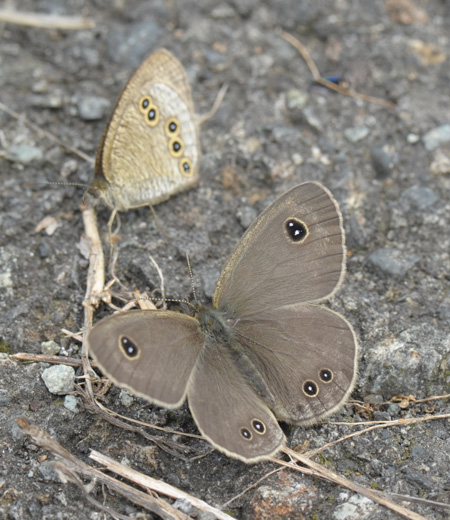 Main Region: Hokkaido, Honshu, Shikoku, Kyushu, Yaku Island and Tanega Island.
Main Region: Hokkaido, Honshu, Shikoku, Kyushu, Yaku Island and Tanega Island.
Found in various kinds of places including woods, and surrounding farmlands, rivers, swamps and bushes from flatlands to low elevations.
Have large eyespots, one on fore wings and two on hind wings.
Similar species, the Japanese rings only have one eyespot on each hind wings, thus it is easy to distinguish them from this species.
Both species have fine ripples-like patterns with eyespots.
Active during daytime, rest on leaves in bushes and fly around.
Adults feed on nectar of flowers including ixeris dentata and creeping woodsorrel.
Caterpillars feed on leaves of plants in poaceae family including oplismenus undulatifolius and miscanthus sinensis.
●Wingspan about 33 to 40 mm
●Adult Flight Season April to about September -
Zizeeria maha (Pale Grass Blue) Lycaenidae
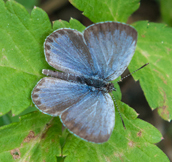
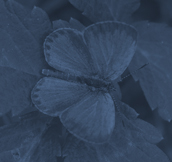 Zizeeria maha (Pale Grass Blue) Lycaenidae
Zizeeria maha (Pale Grass Blue) Lycaenidae Main Region: Honshu, Shikoku, Kyushu and Nansei Islands.
Main Region: Honshu, Shikoku, Kyushu and Nansei Islands.
Found in grasslands and rivers from flatlands to low elevations.
Also found in cities where creeping woodsorrel grow where caterpillars feed on.
Wing color on the front is blue to purple-blue with black edges and on the back is light brown color with shaded patterns with many black spots.
Are active during daytime and feed on nectar of creeping woodsorrel and white clover.
●Wingspan about 25 to 30 mm
●Adult Flight Season March to about November -
Celastrina argiolus (Holly Blue) Lycaenidae
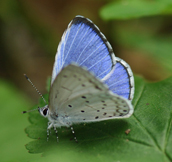
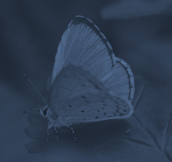 Celastrina argiolus (Holly Blue) Lycaenidae
Celastrina argiolus (Holly Blue) Lycaenidae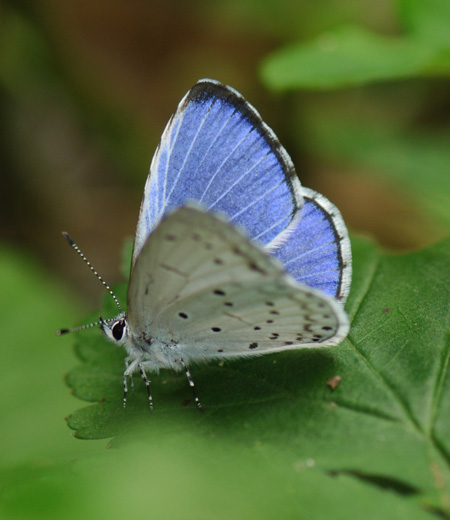 Main Region: Hokkaido, Honshu, Shikoku, Kyushu, Tanega Island, Yaku Island and Amami Island.
Main Region: Hokkaido, Honshu, Shikoku, Kyushu, Tanega Island, Yaku Island and Amami Island.
Found in woods, green spaces and rivers from flatlands to mountains.
Adult flight season is long from early spring to late autumn and often seen at parks and farmlands in cities.
Wing color of male is light purple-blue to blue, lazuline color, hence the Japanese name Ruri-Shijimi literally meaning lazuline lycaenidae.
Female has less blue parts with wider black edges on the front.
And on the back, both male and female is light gray colored with black spots.
Adults are active in woods and grasslands during daytime and feed on nectar of Japanese wisteria and Japanese clover.
Caterpillars feed on flowers and flower buds of plants in fabaceae, cornaceae, Fagaceae and Rutaceae family.
●Wingspan about 22 to 25 mm
●Adult Flight Season March to about November -
Lampides boeticus (Long-tailed Blue) Lycaenidae
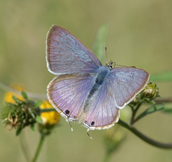
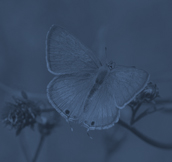 Lampides boeticus (Long-tailed Blue) Lycaenidae
Lampides boeticus (Long-tailed Blue) Lycaenidae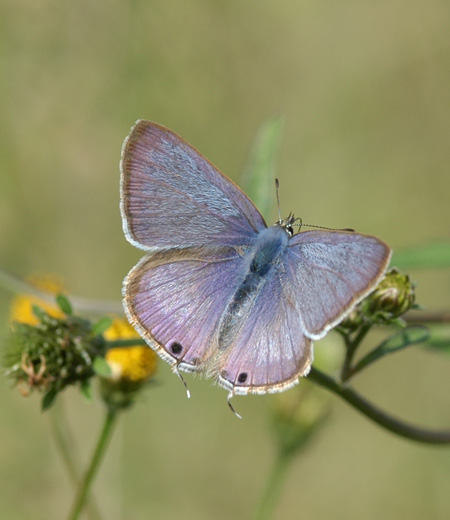 Main Region: South part of Hokkaido, Honshu, Shikoku, Kyushu and Nansei Islands.
Main Region: South part of Hokkaido, Honshu, Shikoku, Kyushu and Nansei Islands.
Found in green spaces or farmlands from flatlands to low elevations.
Japanese name Uranami-shijimi literally meaning wavy pattern on the back lycaenidae, come from the white wavy patterns on the back of wings.
Wing color on the front is shiny light purple with darker edges on male, and darker tone with shiny blue-purple in the center on female.
Have black spots on the lower parts of hind wings.
Is active during daytime and feed on nectar of plants in fabaceae family including peas, fava beans and common bean.
Caterpillars feed on flowers and young fruits in fabaceae family including fava beans and Japanese clovers.
●Wingspan about 28 to 34 mm
●Adult Flight Season July to about November -
Rapala arata (The Japanese Flash) Lycaenidae
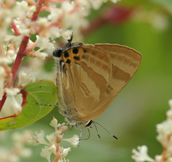
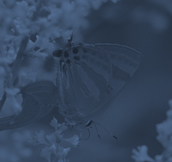 Rapala arata (The Japanese Flash) Lycaenidae
Rapala arata (The Japanese Flash) Lycaenidae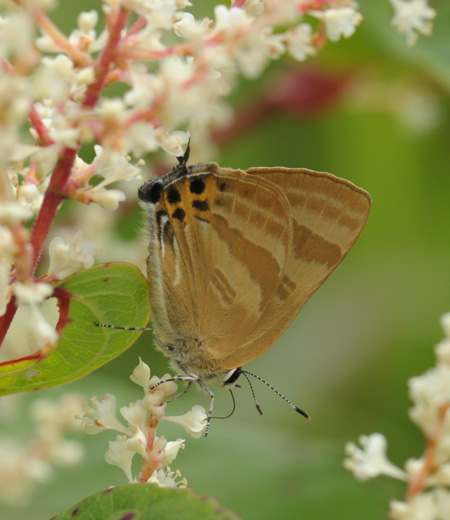 Main Region: Hokkaido, Honshu, Shikoku and Kyushu.
Main Region: Hokkaido, Honshu, Shikoku and Kyushu.
Found in woods and forests along rivers from flatlands to mountain, and also at parks in cities.
Wing color on the front is dusty dark blue and on the back is white and brown stripe-like pattern, hence the Japanese name Torafu-shijimi literally meaning tiger patterns lycaenidae.
Adults emerged in spring have more distinct white stripe-like patterns compare to the ones in summer with more brownish white and white part is less appealing.
Some parts on the back of hind wings are orange and tails on the bottom is long.
Fly fast but does not go long distance and frequently rest on leaves of trees.
Is active during daytime and feed on nectar of Japanese chestnuts.
Caterpillars feed on flowers and sprout of Japanese wisteria and vicia cracca.
●Wingspan about 32 to 36 mm
●Adult Flight Season April to about July -
Curetis acuta (Angeled Sunbeam) Lycaenidae
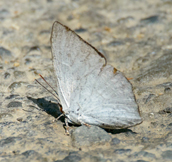
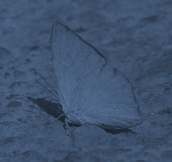 Curetis acuta (Angeled Sunbeam) Lycaenidae
Curetis acuta (Angeled Sunbeam) Lycaenidae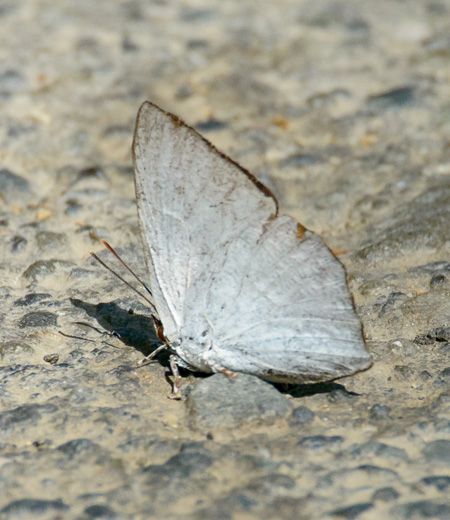 Main Region: Honshu (South of southern Tohoku region), Shikoku, Kyushu and Nansei Islands.
Main Region: Honshu (South of southern Tohoku region), Shikoku, Kyushu and Nansei Islands.
Found in woods and green spaces from flatlands to low elevations.
Wing color is dark brown both for male and female.
Male have orange center and female have white to gray spots.
The back of wings are silver-white, hence the Japanese name Uragin-shijimi silver on the back lycaenidae.
This species have angulated tips of fore wings that is unique to this species.
Adults emerged in autumn have sharper tips than ones in spring.
Fly in forests and over grasslands and feed on nectar and sap.
Found even in paved roads in Mt. Takao.
Caterpillars feed on flowers and flower buds of plants including Japanese wisteria and kudzu.
●Wingspan about 36 to 40 mm
●Adult Flight Season March to about November -
Narathura japonica (Japanese Oakblue) Lycaenidae
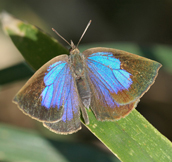
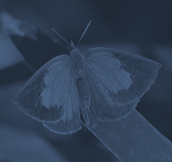 Narathura japonica (Japanese Oakblue) Lycaenidae
Narathura japonica (Japanese Oakblue) Lycaenidae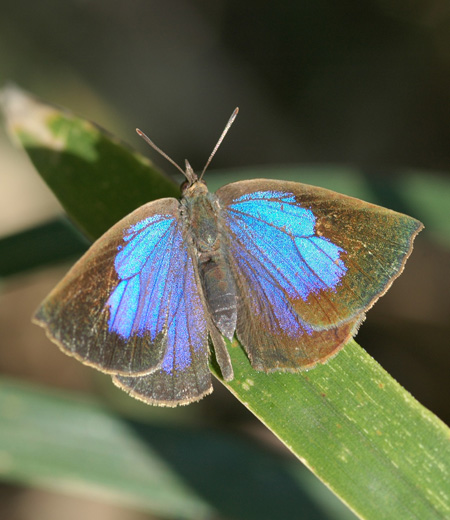 Main Region: Honshu (South of Miyagi), Shikoku, Kyushu and Nansei Islands.
Main Region: Honshu (South of Miyagi), Shikoku, Kyushu and Nansei Islands.
Found in forests and grasslands from flatlands to mountains.
Also found at parks in cities.
Wing color on the front is blue-purple to purple-indigo blue with thick black edges.
On the back is gray-white to dark brown with shaded spots or belt-like patterns.
Also have pointed tips on fore wings.
Is not that active during daytime and become active from late afternoon.
Fly around trees and branches and feed on nectar and sap.
Both male and female suck water.
Adults spend throughout winter at the back of leaves of trees.
Caterpillars feed on plants in fagaceae family including castanopsis and cyclobalanopsis genus.
●Wingspan about 32 to 37 mm
●Adult Flight Season March to about November -
Everes argiades (Short-tailed Blue) Lycaenidae
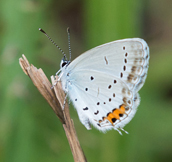
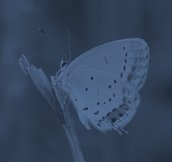 Everes argiades (Short-tailed Blue) Lycaenidae
Everes argiades (Short-tailed Blue) Lycaenidae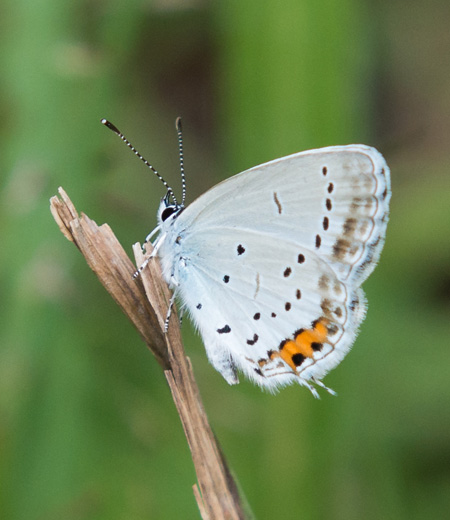 Main Region: Hokkaido, Honshu, Shikoku, Kyushu and Tanega Island and Yaku Island.
Main Region: Hokkaido, Honshu, Shikoku, Kyushu and Tanega Island and Yaku Island.
Found in sunny grasslands and woods from flatlands to low elevations.
Wing color on male is blue-purple with darker colored edges.
Female is mostly black-brown but some are blue colored.
The back of wings is light gray with some black spots and orange patterns on the bottom of hind wings.
Have elongated tails on the bottom of hind wings resembling tails of barn swallows, hence the Japanese name Tsubame-shijimi literally meaning barn swallows lycaenidae.
However, most of butterflies in lycaenidae have similar tails like this species.
Is active during daytime in grasslands and forests and feed on nectar from Japanese clover.
Caterpillars feed on flowers and sprouts in fabaceae family including white clover and indigofera pseudotinctoria.
●Wingspan about 35 to 40 mm
●Adult Flight Season March to about October -
Callophrys ferrea (Tailless Hairstreak) Lycaenidae
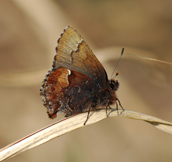
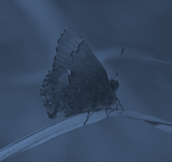 Callophrys ferrea (Tailless Hairstreak) Lycaenidae
Callophrys ferrea (Tailless Hairstreak) Lycaenidae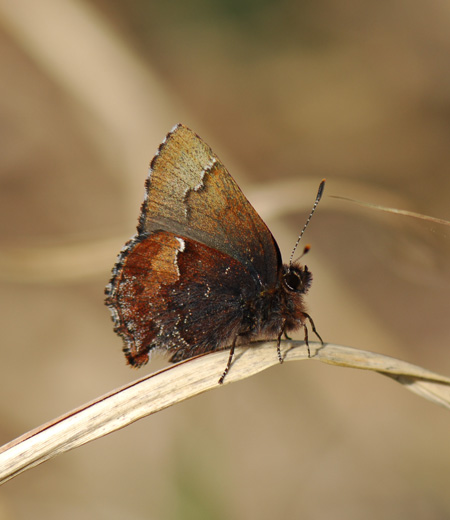 Main Region: Hokkaido, Honshu, Shikoku and Kyushu.
Main Region: Hokkaido, Honshu, Shikoku and Kyushu.
Found in woods on hills and open spaces in mountains and appear as spring comes.
Wing color on female is light metallic blue and male is black-brown with blue in the center.
The back of wings is dark brown with white wave-like patterns and gray small spots on hind wings.
The entire body is covered with hair.
Fly fast and is active from the morning.
Feed on flowers of azalea and pieris japonica subsp. japonica.
Caterpillars feed on flowers and leaves of plants in ericaceae family.
●Wingspan about 25 to 29 mm
●Adult Flight Season April to about May -
Lycaena phlaeas (Small Copper) Lycaenidae
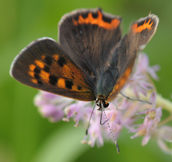
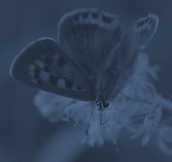 Lycaena phlaeas (Small Copper) Lycaenidae
Lycaena phlaeas (Small Copper) Lycaenidae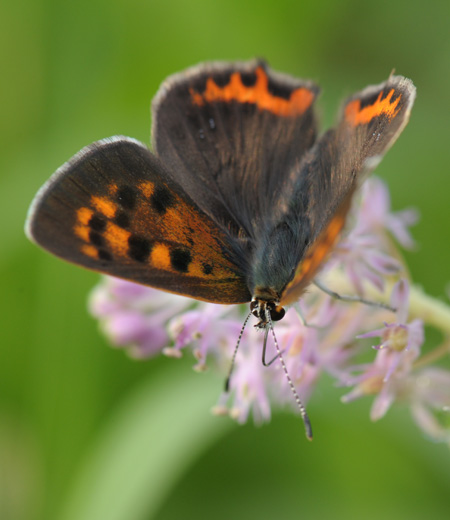 Main Region: Hokkaido, Honshu, Shikoku, Kyushu, Okushiri Island, Rishiri Island, Tanega Island and Yaku Island.
Main Region: Hokkaido, Honshu, Shikoku, Kyushu, Okushiri Island, Rishiri Island, Tanega Island and Yaku Island.
Found in grasslands and small grass fields from flatlands to mountains.
Wing color on the front of fore wings is orange with brown edges and black spots inside of these edges.
Some look black-brown without this red-brown color.
The back of fore wings is widely red-brown and hind wings is darker red-brown belt-like patterns on edges.
Fly closer to the ground and feed on nectar of flowers including annual fleabane.
Caterpillars feed on leaves of common sorrel and rumex japonicus.
●Wingspan about 27 to 35 mm
●Adult Flight Season March to about November -
Japonica lutea (Orange Hairstreak) Lycaenidae
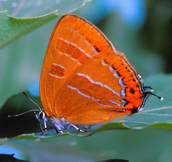
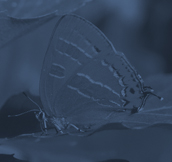 Japonica lutea (Orange Hairstreak) Lycaenidae
Japonica lutea (Orange Hairstreak) Lycaenidae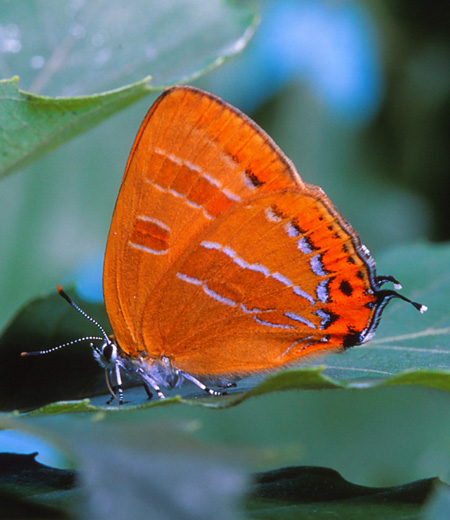 Main Region: Hokkaido, Honshu, Shikoku, Kyushu, Sado Island and Awaji Island.
Main Region: Hokkaido, Honshu, Shikoku, Kyushu, Sado Island and Awaji Island.
Wing color on the front is rather orange than red with black on tips.
Have some reddish parts on the back with black spots and some light white lines in the center.
Habitat area is deciduous broad-leaved forest from flatlands to mountains.
During daytime, adults rest under the trees of quercus serrata and quercus acutissima that caterpillars feed on and become active in late afternoon and feed on nectar of Japanese chestnuts.
Caterpillars feed on leaves of quercus serrata, quercus acutissima, quercus crispula blume and daimyo oak.
Adults emerge from about May and live only for one month.
●Wingspan about 35 to 42 mm
●Adult Flight Season May to about June
